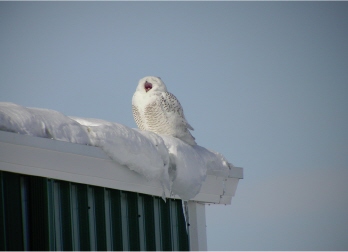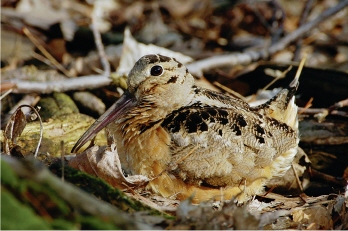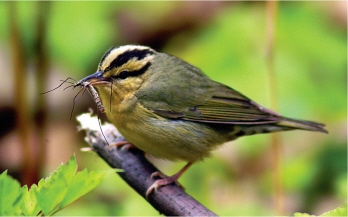The Reluctant Twitcher (8 page)


Photo by
Jean Iron.
Snowy Owl. Holland Marsh. This is a sight that a vole hopes never to see.
Margaret and I take up position and wait an hour; lots of riff-raff, but no Harris's. Finally, a new flock of sparrows arrives out of nowhere and I think I see the Harris's among them. Confirmation is rendered impossible by the vicious dive-bombing attack of the biggest bloody female Cooper's Hawk I've ever seen. For the next ten minutes we observe a few blowing feathers. Is it to be the Ross's Gull at Port Weller all over again, or has our bird survived? Over the next half hour the flock slowly returns. No Harris's. I am getting hungry and feeling weak, but Margaret is showing no signs at all of losing focus; she stares relentlessly at the feeder. I am ashamed to mention my dreadful leg cramps.
But patience is rewarded â something that rarely happens in real life â and the Harris's suddenly materializes, stays for about fifteen seconds, and then disappears like a ghost, to be seen no more. But I don't care; the fifteen seconds were sweet, even if the bird was in winter plumage and a tad ratty. As Hugh would say, it's a tick.
The next day finally yields a Wild Turkey. I feared for a while to be the only birder in Ontario to miss Wild Turkey in 2007. I'd never
looked
for one before; it was always one of those birds you see all the time when not looking. I also nearly miss the Cobourg Laughing Gull. On March 5, I scan the harbour for hours in the bitter cold and wind before finally attempting to get out of the car and have a further look. I say attempt because I nearly step on the Laughing Gull, which is lounging in the parking lot right beneath my vehicle door waiting for a handout. It is miffed and I have to close my door again quickly. Unlike Doug McRae, I don't routinely stock up on donuts before going for gulls â but then I don't go for gulls in my pyjamas either. As Ron Pittaway later says of this bird, “It was too easy.” Not much satisfaction, true â but a tick.
March 12, Gray Partridge seen with Hugh and Andrew Don (Andrew really thinks he spotted them first) right out in the open by the runway at the Brantford airport after a thorough search of the entire surrounding neighbourhood, tramping around in deep snow and grass, Hugh in his tennis shoes.
March 14, I find my own Harlequin Duck at Lucas Point east of Cobourg. A first-winter bird â sweet bird of youth.
March 26, American Woodcock and a close brush with death. I visit Margaret's favourite woodcock site alone at dusk. I look and listen and see diddly-squat. I decide to stray down the road from the car. When it is nearly dark I hear a loud
peent
almost in my ear. I know the bird is very close. Seconds later I see it in all its glory, though to the naked eye it is just a black shape. Let's hear it for the light-gathering power of binoculars. I enjoy the spectacle and flights for ten minutes, until suddenly all hell breaks loose right behind me in the woods. The coyotes go crazy. I can hear their teeth snapping and the drool hitting the ground. Am I the source of such frenzied excitement? I walk briskly, trying hard to give the appearance of nonchalance as I make a beeline for my distant car. How could I have walked so far from it at night?
Stay calm, Poper, stay calm. Do not give in to those powerful, if
subliminal, promptings toward lycanthropic delights put forth so
urgently in your dreams.
I do not take off my clothes. Before they can swarm me and drink deeply of hot blood, I dive into my car. I open the window and howl madly in frenzied relief.
The next day Margaret says, “Oh, yes, I forgot to mention there is the odd coyote in the area.” Yeah, the odd one and a hundred even ones, too. No one ever said birding was safe, though some elderly dotards may actually think so.
April 2, Margaret and I get the Eared Grebe at the Grimsby lagoons. Easy peasy. It comes, however, like most good birds, with a price tag. But I learn a lesson. Instead of taking the easy roundabout way, we decide to head directly for Long Point through the countryside. I have a fairly good idea of how to do it, but since Margaret will be navigating, I relax utterly and bask in the Eared Grebe. We fall to chatting. I mention David Mitchell's stunning tour de force
Cloud
Atlas
. Margaret has read the book and has impassioned views. We are about in mid-book when I come to a stop at an unfamiliar T junction. I ask my navigator which way to turn. She hems and haws. None of the many toponyms on the signposts for either direction are familiar. No problem. Margaret will consult the map book. Several minutes of concerned silence, interspersed with uneasy looks at the signposts and the road numbers.

Photo by
Sam Barone.
American Woodcock. Rondeau Provincial Park. It can be very difficult to
see these birds when they are hunkered down.
“Odd,” says Margaret. “I can't find any of these roads.”
There turns out to be a reason for this. Our exact location is three full maps away from where Margaret thinks we are. We have gone hundreds of kilometres out of our way and have to make a huge loop back to get on track. Margaret “can't understand” how it could have happened. I understand exactly. I tell her about the time I was driving from New York to Indianapolis on automatic pilot and apparently took the wrong Y somewhere and ended up at Cleveland before realizing what had happened, thereby adding a full day onto my journey. She is not mollified.
Though we miss the Eurasian Wigeon at Long Point, we do get six new birds and this assuages the grief, pain, humiliation, and mortification, if not the sorrow and despair. I now check maps before having Margaret navigate. And I never discuss literature with her in a moving vehicle.
April 27, I get the Yellow-throated Warbler at Stoney Creek. Quick and easy the way Hughie likes 'em. Fabulous viewing, though Dave Beadle complains plaintively that the bird is too far away for good shots with his video camera, until Andrew Don pishes the bird in so close that Beadle is forced to complain equally bitterly that now the bird is too close. We are all pleased, even Dave, because it is a yellow-lored bird, not the usual
albilora
. Hugh does not mention the grave once on the way home.
May 1, I get the first of many Marbled Godwits for the year on Amherst Island, having been told by a guy without a scope that the bird is definitely not there â a pleasing way to find a bird. I do not know at the time that I shall see many of these birds all over the province this year. It's good to have a few extras in the bank for the horse-trading on New Year's Eve if one is stuck around 299. You know the kind of thing: I'll give ya three Marbled Godwits, a White Pelican, and as many Black-billed Magpies as you want for your Razorbill or Dickcissel.

Photo
by Andrew Don.
Yellow-throated Warbler.
Edgelake Park, Stoney
Creek. Andrew pished this
rarity down almost into
our hands.
All in all, I feel I am in pretty good shape at 182 species before I leave for Point Pelee on May 7.

God's colors are all fast.
â J
OHN
G
REENLEAF
W
HITTIER
M
ONDAY MORNING
, May 7, finds Felicity and me heading for Point Pelee, a riotous kaleidoscope of colours swirling in my mind. We go during the week, since Felicity doesn't enjoy the crush on the Point. Then we spend a week on the Island with peace and quiet where we can visit the Pelee Island Bird Observatory and see warblers in the hand and hear Graeme Gibson the Younger explain the meaning of banding to the birds he so loves (if you have to be banded, this is the guy to be banded by) â and all this for free. Anyway, since we are not going to the annual convention of the North American Phragmites Society, we do not go straight to Stoney Point, in spite of wondrous memories of Yellow-headed Blackbird and Least Bittern in the pre-Phragmites era. This pleases Felicity because it also means we do not have to stop in Comber. She hates Comber; I suppose not least because we never see anything there. She was not there the time in the late fifties when my father and I had the male Kentucky Warbler only three metres away from us foraging in a half-submerged toilet bowl with fetching blue glyphs right beside the lagoon trail. She has no memories of the place. Anyway, she is pleased that for once we are heading for Rondeau Provincial Park to make a quick stop en route to Pelee for a reported Cerulean Warbler.
P
ELEE
A
REA
T
RIP
H
IGHLIGHTS
Cerulean Warbler.
Seen at eye level, feeding just above the water in the pond near the old horse stables at Rondeau â a breathtaking male.
Worm-eating Warbler.
Also seen at and below eye level at point-blank range almost necessitating a reverse-bins look in Tilden's Woods in Point Pelee National Park â a very bright peach-coloured male.
Summer Tanager.
Seen consuming bees at the “bee tree” at the first Y in Tilden's Woods.

